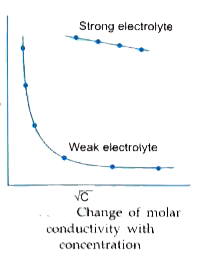A voltaic cell is set up at 25∘C with following half cells : Ag+(0.001M)∣Ag and Cu2+(0.10M)∣Cu What would be the voltage of this cell ? (E∘cell=0.45V)
To find the voltage of the voltaic cell set up with the given half-cells, we can follow these steps:
1. Identify the Half-Reactions:
- For the silver half-cell:
Ag++e−→Ag(E∘=+0.80V)
- For the copper half-cell:
Cu2++2e−→Cu(E∘=+0.34V)
2. Determine the Anode and Cathode:
- The half-cell with the higher standard reduction potential will act as the cathode (reduction), and the one with the lower standard reduction potential will act as the anode (oxidation).
- Here, silver has a higher reduction potential than copper, so:
- Cathode: Ag half-cell (reduction)
- Anode: Cu half-cell (oxidation)
3. Write the Overall Cell Reaction:
- The oxidation reaction at the anode:
Cu→Cu2++2e−
- The reduction reaction at the cathode:
2Ag++2e−→2Ag
- Combining these gives the overall cell reaction:
Cu+2Ag+→Cu2++2Ag
4. Calculate the Reaction Quotient (Q):
- The reaction quotient Q is given by:
Q=(Cu2+)(Ag+)2
- Substituting the concentrations:
Q=0.10(0.001)2=0.100.000001=100000
5. Use the Nernst Equation:
- The Nernst equation is:
E=E∘−0.0591nlogQ
- Here, E∘ for the cell is given as 0.45V and n=2 (number of electrons transferred).
- Plugging in the values:
E=0.45−0.05912log(100000)
6. Calculate the Logarithm:
- Since log(100000)=5:
E=0.45−0.05912×5
E=0.45−0.14775
E=0.30225V
Final Answer:
The voltage of the voltaic cell is approximately 0.302 V.
- For the silver half-cell:
Ag++e−→Ag(E∘=+0.80V)
- For the copper half-cell:
Cu2++2e−→Cu(E∘=+0.34V)
- The half-cell with the higher standard reduction potential will act as the cathode (reduction), and the one with the lower standard reduction potential will act as the anode (oxidation).
- Here, silver has a higher reduction potential than copper, so:
- Cathode: Ag half-cell (reduction)
- Anode: Cu half-cell (oxidation)
- The oxidation reaction at the anode:
Cu→Cu2++2e−
- The reduction reaction at the cathode:
2Ag++2e−→2Ag
- Combining these gives the overall cell reaction:
Cu+2Ag+→Cu2++2Ag
- The reaction quotient Q is given by:
Q=(Cu2+)(Ag+)2
- Substituting the concentrations:
Q=0.10(0.001)2=0.100.000001=100000
- The Nernst equation is:
E=E∘−0.0591nlogQ
- Here, E∘ for the cell is given as 0.45V and n=2 (number of electrons transferred).
- Plugging in the values:
E=0.45−0.05912log(100000)
- Since log(100000)=5:
E=0.45−0.05912×5
E=0.45−0.14775
E=0.30225V
The voltage of the voltaic cell is approximately 0.302 V.
Topper's Solved these Questions
- BOOK - DINESH PUBLICATIONCHAPTER - ELECTROCHEMISTRYEXERCISE - IN-TEXT QUESTIONS15videos
ELECTROCHEMISTRY
- BOOK - DINESH PUBLICATIONCHAPTER - ELECTROCHEMISTRYEXERCISE - N.C.E.R.T. EXERCISE18videos
ELECTROCHEMISTRY
- BOOK - DINESH PUBLICATIONCHAPTER - ELECTROCHEMISTRYEXERCISE - ULTIMATE PREPARATORY PACKAGE12videos
ELECTROCHEMISTRY
- BOOK - DINESH PUBLICATIONCHAPTER - D-AND -F BLOCK ELEMENTSEXERCISE - BRAIN STORMING MULTIPLE CHOICE QUESTIONS (MCQS)13videos
D-AND -F BLOCK ELEMENTS
- BOOK - DINESH PUBLICATIONCHAPTER - ETHERSEXERCISE - (MCQs)8videos
ETHERS
Similar Questions
(a) Define molar conductivity of a substance and describe how for weak and strong electrolytes , molar conductivity changes with concentration of solute . How is such change explained ?
(b) A voltaic cell is set up at 25∘C with the following half cells :
Ag+(0.001M) | Ag and Cu2+(0.10M)∣Cu
What would be the voltage of this cell ? (E∘cell=0.46V)View SolutionDefine molar conductivity of a substance and describe how for weak and strong electrolytes, molar conductivity changes with concentration of solute. How is such change explained ? A voltaic cell is set up at 25 °C with the following half-cells :
Ag+(0.001M)∣Ag and Cu2+(0.10M)∣Cu
What would be the voltage of this cell ? [E∘cell = 0.46 V]
 View Solution
View Solution
Knowledge Check
- Question 1 - Select One
The e.m.f. of the cell
Ti∣∣Ti+(0.001M)∣∣∣∣Cu2+(0.01M)∣∣Cu is 0.83V the emf of this cell could b e increased byAincreasing the concentration of Ti+ ionsBincreasing the concentration of Cu2+ ionsCincreasing the concentration of bothDnone of the above. - Question 2 - Select One
The voltage for the cell Fe∣Fe2+(0.0010M) || Cu^(2+)(0.10 M) | Cuis0.807Vat25^(@)C.WˆisthevalueofE∘?
A0.51B1.01C2.5D3.21 - Question 3 - Select One or More
For the cell Tl∣∣Tl+(0.001M)∣∣∣∣Cu2+(0.01M)∣∣Cu.Ecell at 25∘C is 0.83V, which can be increased:
Aby increasing [Cu2+]Bby increasing [TI+]Cby decreasing [Cu2+]Dby decreasing [TI+]
(a) State the relationship amongst cell constant of a cell , resistance of the solution in the cell and conductivity of the solution . How is molar conductivity of solute related to conductivity of its solution ?
(b) A voltanic cell is set up at 25∘C with the following half-cells :
Al∣Al3+(0.001M) and Ni∣Ni2+(0.50M)
Calculate the cell voltage [E∘Ni2+∣Ni=−0.25V,E∘Al3+∣Al=−1.66V]View SolutionA voltaic cell is set up at 25∘Cwith the following half cells :
Al3+(0.001 M) and Ni2+(0.50 M)
Write the equation for the reaction when the cell generates the electric current. Also determine the cell potential (Given E∘Ni2+/Ni=−0.25V,E∘Al3+/Al=−1.66V).View Solution(i) State the relationship amongst cell constant of a cell, resistance of the solution in the cell and conductivity of the solution. How is molar conductivity of a solution related to conductivity of its solution ?
(ii) A voltaic cell is set up at 25 °C with the following half cell,
Al/Al3+(0.001M) and Ni/Ni2+(0.50M)
Calcualte the cell voltage: [E∘ni2+/Ni=−0.25V,E∘Al+/Al=−1.66V]View SolutionWrite the Nernst equation and Cell reaction of the following cell Zn∣Zn2+(0.01)M)∣∣Cu2+(0.01)M)∣Cu
View SolutionAt temperature of 298 K , the e.m.f. of the following electrochemical cell
Ag(s)∣∣Ag+(0.1M)∣∣∣∣Zn2+(0.1M)∣∣Zn(s) will be ___________. (Given E∘cell=−1.562V)View Solution

